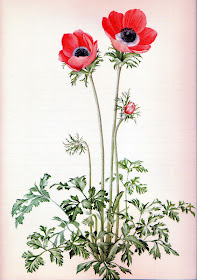Anemone coronaria 'de Caen'
Sometimes you get just one line of historical information and you have to use your imagination to fill in the gaps as to the how and why. The French did a lot of hybridizing and improving of this Spring flowering native bulb in the 18th Century and I am wondering whether it is because the resulting flower colours of mainly red, white and blue perfectly reflected their flag and were used in patriotic bedding displays to herald the spring. The breeding work was done in the Normandy region of northern France, hence this single flowered form is named for the city of Caen and the double flowered form is named for one of the Saints of spring, the Irish St. Brigid. Down in Spain, where it is also native, it is given the common name of Spanish Poppy because the red flowered variety has a resemblance to the famous Flanders Poppy.
This is a bulb which is quite hardy in warm climates and less so in extremely cold ones. American Louise Beebe Wilder gave it the thumbs down for the very cold North American States but wrote very eloquently about other members of the race: Of all the flowers that flicker briefly across the worn brown garment that is spring, none are more tenderly beguiling than the Anemones. They do not charm by splurge but by far gentler arts.
Anemones, which droop their eyes
Earthward before they dare arise
To flush the border....
Earthward before they dare arise
To flush the border....
From a horticultural point of view, bulbs are usually purchased in late summer and planted anytime from late February onwards, but herein lies a problem. The bulbs, which resemble wrinkly toes which have emerged from a long soak in a bathtub, may rot if the the conditions are too wet and humid. They have a bit of a flat dorsal side from which the parsley like leaves and flower buds emerge and I planted mine in a store bought 'bulb fibre mix' which proved to be too moisture retentive so I had many casualties early in the season. Then you have that problem of temperature fluctuation in autumn where some plants are tricked into thinking that it is spring and half heartedly flower too early, not unlike what vegetable growers experience when their crop bolts to seed prematurely. Eventually things settle down and the flowers, which emerge over late winter, are carried singly on strong straight stems and put on a wonderful show of opening, closing ,nodding and swaying in the breeze or gale as the case may be. I only planted red and white ones this year, though the blue, which is a dark navy blue, has blue black stamens like silky orphington chicken feathers. Next year for that one. Though they are best treated as an annual, it is worth saving the seed which can be planted in late summer. This is what I am hoping to do to see what success I have in growing them from seed. Always a challenge.
The painting of Anemones below is by Australian botanical artist and writer Joan Law-Smith (1919-1998). What I like about her very refined and elegant work is that it has an elongated perspective, and in a slightly surreal way, she always make you feel as if you have drunk the shrinking potion of Alice in Wonderland and are left looking up at a giant tree sized flower.
Anemone from A Gardener's Diary by Joan Law-Smith
Published in 1976 by Women's Committee of the National Trust of Australia (Victoria)
Street Art in Caen, France by 'Inkflottante'




No comments:
Post a Comment